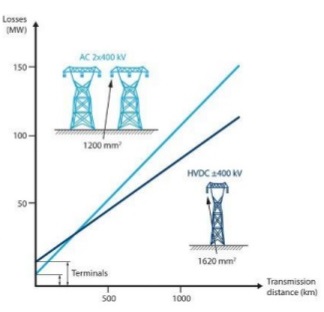Generally there are two power transmission and distribution systems that are used to transmit electrical energy i.e. HVDC or High Voltage Direct Current transmission system and HVAC or High Voltage Alternating Current transmission system. Now let’s see the advantages and disadvantages of both power distribution systems.
COMPARISION OF HVAC & HVDC SYSTEMS
- HVAC transmission is having several limitations like line length, uncontrolled power flow, over/low voltages during lightly / over loaded conditions, stability problems, fault isolation etc
- The advantage of HVDC is the ability to transmit large amounts of power over long distances with lower capital costs and with lower losses than AC.
- HVDC transmission allows efficient use of energy sources remote from load centers. Depending on voltage level and construction details, losses are quoted as about 3% per 1,000 km
- In a number of applications HVDC is more effective than AC transmission. Examples include undersea cables, where high capacitance causes additional AC losses. (e.g. 250 km Baltic Cable between Sweden and Germany)
- 600 km NorNed cable between Norway and the Netherlands
- In HVDC Long power transmission without intermediate taps, for example, in remote areas.
- Increasing the capacity of an existing power grid in situations where additional wires are difficult or expensive to install.

HVDC Principal
- Power transmission and stabilization between unsynchronized AC distribution systems.
- Connecting a remote generating plant to the distribution grid.
- Asynchronous operation possible between regions having different electrical parameters.
- Facilitate power transmission between different countries that use AC at differing voltages and/or frequencies
- Reducing line cost, fewer conductors and thinner conductors since HVDC does not suffer from the skin effect.
ADVANTAGES OF USING HVDC TRANSMISSION SYSTEM
- HVDC (high-voltage direct current) is a highly efficient alternative for transmitting large amounts of electricity over long distances and for special purpose applications. Compared to alternating current, the direct current system is less expensive and loses less energy. HVDC can be transmitted through cables both underground and underwater.
- No problem of capacitance, phase displacement, inductance and surge.
- About 70% potential stress compared to that of AC transmission system for the same voltage. Thereby reducing the insulation cost.
- HVDC uses only two conductors for transmission. Furthermore, use of only one conductor is also possible but with earth as return path.
HVDC Technical Advantages
- Reactive power requirement
- System stability
- Short Circuit Current
- Independent Control of ac system
- Fast change of energy flow
- Lesser Corona Loss and Radio interference
- Greater Reliability.
- Direction of power flow can be changed very quickly
- Large HVDC schemes (5000 MW – 6400 MW) are used to access remote hydro power resources, hence renewable energy with no CO2 emissions.
- HVDC is more economical than HVAC for schemes with transmission distances more than 700 km.
HVDC Economic Advantages
- DC lines and cables are cheaper than AC lines or cables.
- The towers of the DC lines are narrower, simpler and cheaper compared to the towers of the AC lines.
- Line losses in a DC line are lower than the losses in an AC lines.

- The diagram shows a comparison of the losses in 1,200 MW overhead line transmissions using AC and HVDC.
Lower Investment Cost: It is true that HVDC terminal stations are more expensive due to the fact that they must perform the conversion from AC to DC, and DC to AC. But over a certain distance the so called “break-even distance” (approx. 600 – 800 km), the HVDC alternative will always provide the lowest cost
ADVANTAGES OF USING HVAC TRANSMISSION SYSTEM
A three phase AC transmission is generally used instead of HVDC transmission system, even though the latter has many advantages, because:
- Stepping up and stepping down is easy in AC transmission system.
- Ease of transforming in AC sub-station than in motor-generator sets of DC system.
- Low maintenance
- More economical
DISADVANTAGES OF USING AC TRANSMISSION SYSTEM
- Skin effect and proximity effects.
- More volume of conductor is required.
- More possibility of corona effect.
- Line reactance which cause change in voltage regulation of transmission system.
- Proper synchronization required while connecting two or more transmission line.
- Complicated transmission network.
Other Challenges with AC Power Lines include:
- AC lines become loaded closer to their thermal capacity with increasing losses.
- Reduced power quality causes the risk of declining network stability.
- Overhead lines change the landscape, causes public resentment.
- Limit the distance of traditional AC underground cables to around 80km.
Discover more from Electrical Engineering 123
Subscribe to get the latest posts sent to your email.

